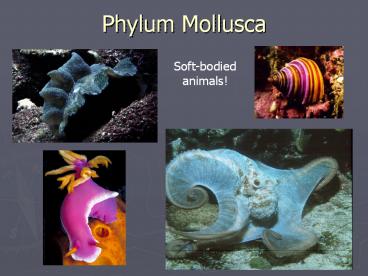Phylum Mollusca - PowerPoint PPT Presentation
1 / 30
Title:
Phylum Mollusca
Description:
Phylum Mollusca Soft-bodied animals! 3 Classes of Molluscs GASTROPODA : includes limpets, snails, slugs and whelks BIVALVIA: includes clams, oysters, mussels ... – PowerPoint PPT presentation
Number of Views:428
Avg rating:3.0/5.0
Title: Phylum Mollusca
1
Phylum Mollusca
Soft-bodied animals!
2
3 Classes of Molluscs
GASTROPODA includes limpets, snails, slugs
and whelks BIVALVIA includes clams, oysters,
mussels, scallops and shipworms CEPHALOPODA
includes octopi, squid, cuttlefish, and nautilus
Above Limpet
Above Scallop showing off its eyes! Left
Cuttlefish and squid
3
All forms of Molluscs have a body with three
parts
- Visceral Mass
- - The soft bodied portion that contains the
internal organs - Foot
- - A strong, muscular portion used for moving
(or tentacles in cephalopods) - Mantle
- A covering that goes around the visceral mass
- Can secrete a shell
4
Find the Foot, Visceral Mass and Mantle!
5
A diverse phylum
- Mollusca contains 80,000 different species
- Symmetry Bilateral
- Level of Organization Organ
- They also have a well developed nervous system, a
circulatory system, and a brain. - Cephalopods have a closed circulatory system
(e.g. squid, octopus) - Bivalves and Gastropods have an open circulatory
system (e.g. clams, snails)
6
- Feeding
- Complete digestive tract
- Most have a radula a sharp tongue like a nail
file that they use to rasp at food - Feeding strategies differ between the classes
- Excretion
- Complete excretory system with an anus
- Simple kidneys
- Reproduction
- Sexual with internal fertilization
- Most have separate sexes, although snails are
usually hermaphroditic
7
Class Bivalvia
- Two valves (shells), e.g. mussels, clams, oysters
- They have a muscular foot for digging
- They often attach to the substrate with byssal
threads that hold them in place - Some, like scallops, can swim
8
- Siphons (tubes to carry water into and out of the
animal) - A muscle holds the valves (shells) together
- No head, radula or true eyes (eyespots only)
- Gills for getting oxygen from the water
- Open circulatory system
9
Above left Elephant trunk clams, named for their
large foot Above right an opened oyster commonly
enjoyed raw or cooked as a delicacy Lower right
Scallop showing off its many primitive eyes
10
Giant clams have zooxanthellae, just like corals
11
Class Gastropoda
- Gastropod means stomach-foot
- They usually have one shell, e.g. snails
- They have a variety of feeding methods some are
herbivores, some carnivores, some parasites - Some cone snails inject a venom that can be fatal
to humans
12
- Snails have a hard door called an operculum
- Internal fertilization and are often
hermaphrodites - Use a radula for feeding
13
Gastropod Diversity
14
Also in Class Gastropoda The Nudibranch!
- Nudibranch means naked gills
- They have evolved to have no shell
15
- Toxic and have bright beautiful colors as a
warning to predators
- The feathery parts on their backs are their gills
- Two rhinophores that taste the water around
them to sense their environment
16
Top 5 reasons why Nudibranchs are so cool
- 5. They are amazing colours
- 4. They can eat toxic sponges without being
harmed, but can transfer the toxin to a predator
if bitten - 3. Hermaphroditic nudibranchs battle to be the
one to inject the other with sperm.
17
- 2. They can eat nematocysts from corals and
anemones without getting stung. The next thing
that touches them gets the sting! - 1. A nudibranch can eat algae and take the
chloroplasts into its own body. It can then
perform PHOTOSYNTHESIS!
18
Class Cephalopoda
- Their name means
- head foot
- E.g. Octopus, squid, cuttlefish
19
- They have 8 (or more) arms
- They can push a jet of water out their siphon,
allowing them to move quickly - An ink sac allows them to eject ink as decoy
20
- The Nautilus has a shell with chambers that
allows it to change depth easily (they are great
hunters)
21
- Many cephalopods have no shell
- Squid and cuttlefish have a hard part inside
- Octopus have no hard parts except for their mouth
22
- Cephalopods have a very well developed nervous
system - nerves can carry messages TEN times faster than
in humans - Their eye is complex and has 180 degree vision
out of the sides of their heads
23
(No Transcript)
24
- They have a developed brain and can solve
problems - Mouth is called a beak
- They have internal fertilization and have
separate sexes - male has a special tentacle used to put sperm
packets inside the female - Squid mate in a big group
25
- Female octopus lay thousands of eggs in a cave
and guards them until she dies
26
Octopus
Octopus on the beach
Octopus beak
Swimming Octopus
Octopus arm in detail
27
- Many have photophores that allow them to produce
light - Most also have chromatophores that allow them to
change color to match their background
28
(No Transcript)
29
Squid
Caribbean Reef Squid
Tentacles of a giant squid
Calamari a deep fried squid dish
Squid eye and gills
30
Squid Fact
- The largest squid ever caught was a 10 m long
Colossal Squid off the coast of New Zealand and
weighed in at 495 kg. Colossal Squid are larger
than the giant squid found off the Mexican coast
and are thought to grow in size to 13 meters!

